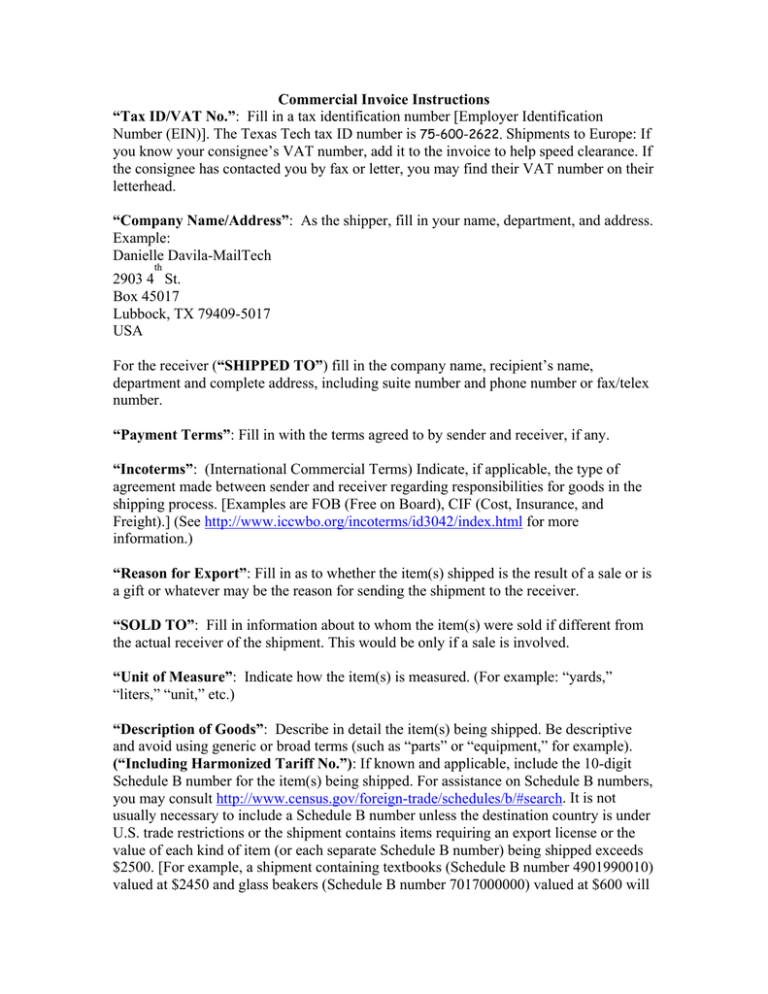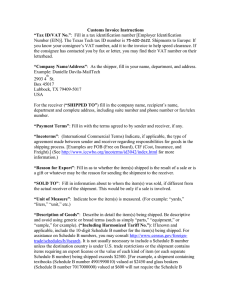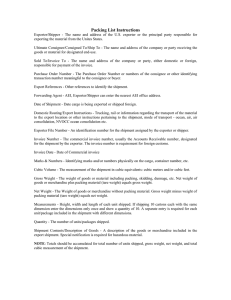Commercial Invoice Instructions “Tax ID/VAT No.” Shipments to Europe: If
advertisement

Commercial Invoice Instructions “Tax ID/VAT No.”: Fill in a tax identification number [Employer Identification Number (EIN)]. The Texas Tech tax ID number is 75-600-2622. Shipments to Europe: If you know your consignee’s VAT number, add it to the invoice to help speed clearance. If the consignee has contacted you by fax or letter, you may find their VAT number on their letterhead. “Company Name/Address”: As the shipper, fill in your name, department, and address. Example: Danielle Davila-MailTech th 2903 4 St. Box 45017 Lubbock, TX 79409-5017 USA For the receiver (“SHIPPED TO”) fill in the company name, recipient’s name, department and complete address, including suite number and phone number or fax/telex number. “Payment Terms”: Fill in with the terms agreed to by sender and receiver, if any. “Incoterms”: (International Commercial Terms) Indicate, if applicable, the type of agreement made between sender and receiver regarding responsibilities for goods in the shipping process. [Examples are FOB (Free on Board), CIF (Cost, Insurance, and Freight).] (See http://www.iccwbo.org/incoterms/id3042/index.html for more information.) “Reason for Export”: Fill in as to whether the item(s) shipped is the result of a sale or is a gift or whatever may be the reason for sending the shipment to the receiver. “SOLD TO”: Fill in information about to whom the item(s) were sold if different from the actual receiver of the shipment. This would be only if a sale is involved. “Unit of Measure”: Indicate how the item(s) is measured. (For example: “yards,” “liters,” “unit,” etc.) “Description of Goods”: Describe in detail the item(s) being shipped. Be descriptive and avoid using generic or broad terms (such as “parts” or “equipment,” for example). (“Including Harmonized Tariff No.”): If known and applicable, include the 10-digit Schedule B number for the item(s) being shipped. For assistance on Schedule B numbers, you may consult http://www.census.gov/foreign-trade/schedules/b/#search. It is not usually necessary to include a Schedule B number unless the destination country is under U.S. trade restrictions or the shipment contains items requiring an export license or the value of each kind of item (or each separate Schedule B number) being shipped exceeds $2500. [For example, a shipment containing textbooks (Schedule B number 4901990010) valued at $2450 and glass beakers (Schedule B number 7017000000) valued at $600 will not require the Schedule B numbers because neither kind of item (books and beakers) exceeds $2500 separately.] (For more information on the SED, see http://www.census.gov/foreign-trade/www/correct.way.html.) “Value Unit”: Assign a value to each item in the shipment. “Special Instructions”: Include any special instructions for the shipment which may affect handling or carriage by the commercial carrier or other instructions that other parties handling the shipment may need to know. “Declaration Statements”: Include any additional information needed to meet any pertinent regulatory or customs requirements. “Invoice Total”: Add up the total values of each line item and ancillary values (such as Insurance or Freight charges), if any, to arrive at a total for the invoice. “Currency Code”: Unit of currency pertaining to shipping costs and goods value. (For example: “USD” for U.S. dollars.) “Signature/Title” and “Date”: The invoice must be signed and dated.


